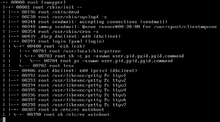This article needs additional citations for verification .(September 2012) |

pstree is a Linux command that shows the running processes as a tree. [1] [2] [3] It is used as a more visual alternative to the ps command. The root of the tree is either init or the process with the given pid. It can also be installed in other Unix systems.
Contents
In BSD systems, a similar output is created using ps -d, in Linux ps axjf [4] produces similar output.